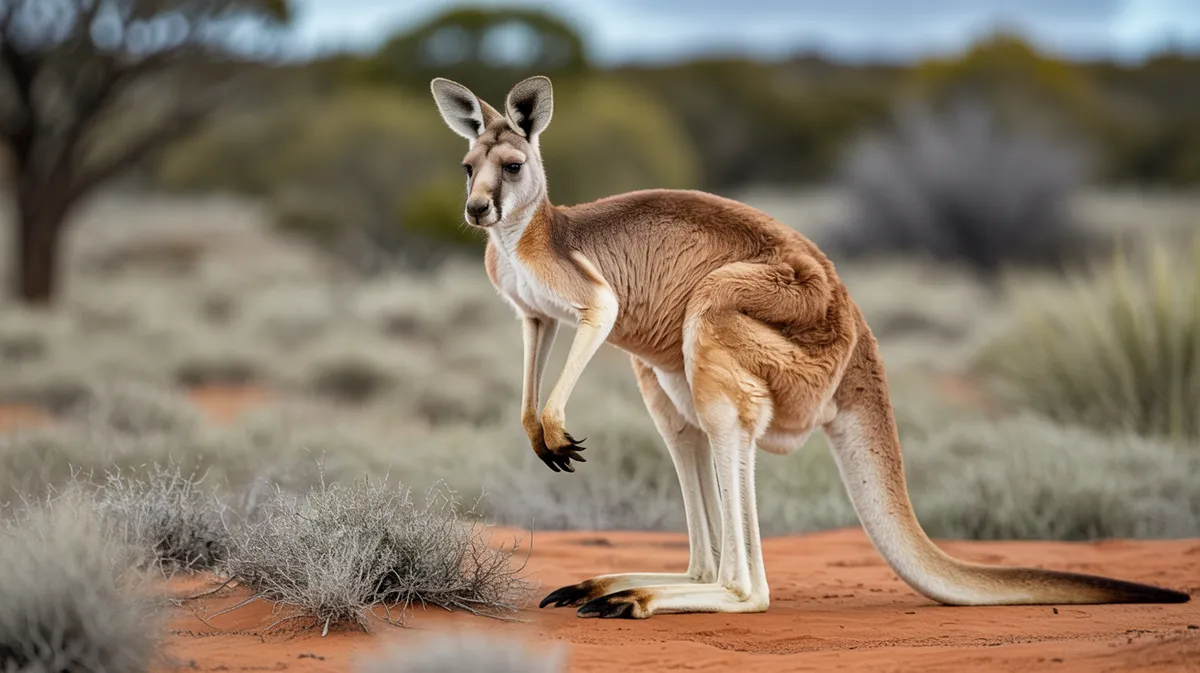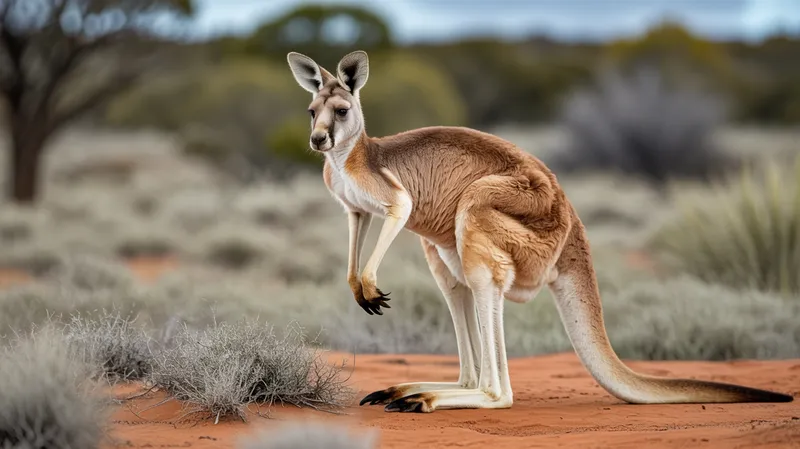
Red Kangaroo
Macropus rufus

Meet the Red Kangaroo
The Red Kangaroo is the largest living marsupial and native terrestrial mammal in Australia. Renowned for its powerful hind legs and long, muscular tail, this iconic species is adapted for efficient hopping across vast, arid inland areas. Males, known as 'boomers,' are much larger and more robust than the smaller females, often displaying a distinctive reddish-brown fur. Red Kangaroos are social animals, usually forming groups called mobs, and are primarily crepuscular, being most active at dawn and dusk. Their remarkable ability to conserve water makes them well-suited to the harsh Australian outback.
Classification
Mammal
Habitat
Open plains, grasslands, and arid desert regions
Diet
Herbivore
Lifespan
12-18 years
Conservation
Least Concern
Weight
18–90 kg (40–200 lbs)
📖Fascinating Facts
Record Jumper
The Red Kangaroo holds the record for the longest leap of any marsupial, able to jump over 9 meters (30 feet) in a single bound.
Desert Survivor
Adapted to arid environments, Red Kangaroos can conserve water efficiently and withstand extreme heat by being active during cooler parts of the day.
Joey Development
A female Red Kangaroo can have three young at different stages at the same time: an embryo in pause, a pouch joey, and a young at foot.
📋Detailed Description
The Red Kangaroo (Osphranter rufus) is the largest extant marsupial, with adult males (boomers) reaching up to 2.8 meters (9.2 ft) in total length—including their powerful tail—and weighing up to 90 kg (200 lbs), while females (flyers) are significantly smaller, typically weighing 18–40 kg (40–88 lbs). Their fur varies from a deep reddish-brown in males to a bluish-grey in females, with lighter underparts. Adapted for life in arid and semi-arid environments, the Red Kangaroo possesses long, muscular hind limbs and large feet, enabling it to travel at sustained speeds of 20–25 km/h (12–16 mph) and leap over 8 meters (26 ft) in a single bound. The species has a highly efficient cooling system, relying on panting, licking their forearms, and seeking shade to regulate body temperature. Red Kangaroos are crepuscular, being most active during dawn and dusk to avoid daytime heat. Socially, they form loose groups called mobs, which can range from a few individuals to over 100, providing protection from predators and facilitating social interactions. Their diet consists almost exclusively of native grasses and forbs, and they can survive long periods without free water by extracting moisture from their food. The Red Kangaroo's reproductive system is highly specialized, with females capable of embryonic diapause—delaying the development of a new embryo until the previous joey leaves the pouch. Lifespans in the wild typically reach 12–18 years, though predation and environmental pressures may reduce this.
💡 Did you know?
A Red Kangaroo can survive for long periods without water by getting moisture from the plants it eats.
🔬Research & Sources
Wikipedia Summary
The red kangaroo is the largest of all kangaroos, the largest terrestrial mammal native to Australia, and the largest extant marsupial. It is found across mainland Australia, except for the more fertile areas, such as southern Western Australia, the eastern and southeastern coasts, and the rainforests along the northern coast.
Last Modified: 5/25/2025
🎭Behavior & Social Structure
Red Kangaroos exhibit a range of behavioral adaptations to their harsh environment. They are primarily grazers, feeding at night or during cooler periods to avoid dehydration and heat stress. Their social structure is fluid, with mobs forming and dispersing based on resource availability and environmental conditions. Dominant males often engage in ritualized 'boxing' contests, using their forelimbs and powerful hind legs to establish hierarchy and mating rights. Communication includes a variety of vocalizations, foot thumping as an alarm signal, and body postures. During the hottest part of the day, individuals rest in the shade, minimizing activity to conserve energy and water. When threatened, they can flee at high speed, using their strong hind legs for rapid, bounding locomotion. Feeding behavior is selective, with a preference for green shoots and high-protein grasses, and they may travel considerable distances to find suitable forage.
👶Reproduction & Life Cycle
Red Kangaroos breed year-round, though reproductive rates peak following significant rainfall when food is abundant. Males compete for access to females through displays of strength and boxing matches. After mating, the gestation period is approximately 33 days, after which a tiny, underdeveloped joey (about 0.8 g) crawls into the mother's pouch to continue development. Pouch life lasts about 190–235 days, after which the joey gradually spends more time outside but continues to nurse for several months. Females are capable of embryonic diapause, allowing them to pause the development of a new embryo until the pouch is vacated. This reproductive strategy enables rapid population growth when conditions are favorable. Parental care is primarily provided by the mother, who nurses and protects the joey until it is fully weaned at around 12 months.
🛡️Adaptations & Survival
Red Kangaroos are superbly adapted to Australia's arid interior. Their large, elongated hind limbs and elastic tendons allow for energy-efficient hopping, which conserves energy and reduces heat production compared to quadrupedal locomotion. Their kidneys are highly efficient at concentrating urine, minimizing water loss, and they can survive on dry forage for extended periods. Behavioral adaptations include nocturnal and crepuscular activity patterns, seeking shade, and licking their forearms to promote evaporative cooling. The ability to delay embryonic development (embryonic diapause) ensures reproductive success in unpredictable environments. Their fur provides insulation against temperature extremes, and their acute senses of hearing and vision help detect predators and locate distant resources.
📚Research Sources
🎨Cultural Significance
The Red Kangaroo is a national symbol of Australia, featured on the country's coat of arms, currency, and as a mascot for sporting teams and events. In Aboriginal Australian cultures, kangaroos hold significant spiritual and practical value, appearing in Dreamtime stories and serving as an important traditional food source. Kangaroo motifs are common in Indigenous art and mythology. The species also plays a role in ecotourism and wildlife conservation education, representing the unique biodiversity of the Australian continent.
🔬Recent Research & Discoveries
Recent research has focused on the biomechanics of kangaroo locomotion, revealing that their hopping is one of the most energy-efficient forms of terrestrial movement among mammals. Studies on reproductive physiology have advanced understanding of embryonic diapause and lactation strategies. Ongoing ecological research monitors population dynamics in response to climate variability and land use changes. Genetic studies have clarified the evolutionary relationships within the Macropodidae family, leading to the reclassification of the Red Kangaroo into the genus Osphranter. Conservation research continues to assess the impact of commercial harvesting and land management practices on population sustainability.
🎥Wildlife Videos

Wildlife | Episode 3: Kangaroos - Kings of the Outback | Free Documentary Nature
Wildlife - Episode 3: Kangaroos - Kings of the Outback | Wildlife Documentary Watch 'Wildlife - Episode 4: World's Largest Land ...
Free Documentary - Nature

The Survival of the Kangaroo: Bushfire, Drought, and Heat Waves (Full Episode) | The Kangaroo King
The scorching interior of the world's oldest continent is home to the toughest kangaroo on the planet, the mighty Red. This is a ...
National Geographic

Secrets of the Outback | Wild Australia in 4K | Wildlife Nature Documentary
To many, Australia's Outback seems barren and inhospitable — a vast, sun-scorched wilderness with little life to offer. But look ...
Into the Wild Films

The Adventures of a Young Kangaroo in Australia | Our World
TALES FROM THE WILD takes some of the most spectacular wildlife moments ever caught on film from the Survival Archive and ...
Our World

Wildlife - The Fascinating World of Wild Animals | Full Series | Free Documentary Nature
Wildlife - The Fascinating World of Wild Animals | Wildlife Documentary Watch 'Ocean Stories - Full Series' here: ...
Free Documentary - Nature

The Insane Biology of: Kangaroos
Imagery courtesy of Getty Images References: [1] ...
Real Science
🌍Habitat Information
The Red Kangaroo typically inhabits Open plains, grasslands, and arid desert regions environments. Red Kangaroos have adapted to their environments with specialized features and behaviors.
Primary Habitat:
Open plains, grasslands, and arid desert regions
More detailed habitat information will be available soon.
🛡️Conservation Status
The Red Kangaroo is currently classified as Least Concern. Conservation efforts are crucial for preserving this species for future generations.
Common Threats:
- 🏠Habitat loss and fragmentation
- 🌡️Climate change impacts
- 🎯Hunting and poaching
- 🏭Human-wildlife conflict
⚠️Threats & Conservation Challenges
While the Red Kangaroo is currently listed as Least Concern by the IUCN, it faces localized threats from habitat degradation, competition with livestock, and fencing, which can restrict movement and access to water. In some regions, they are subject to culling due to perceived competition with agricultural interests. Climate change poses a long-term threat by altering rainfall patterns and vegetation availability. Predation by dingoes and, for juveniles, by foxes and large birds of prey, also impacts populations. Despite these challenges, the species remains widespread and abundant, with population numbers fluctuating in response to environmental conditions.
🔬Scientific Classification
Scientific Name
Macropus rufus
Classification Hierarchy
🔍 About Taxonomic Classification
Taxonomic classification is a hierarchical system used by scientists to classify and organize living organisms based on shared characteristics and evolutionary relationships.
The system moves from broad categories (Kingdom) to increasingly specific ones, with each animal's scientific name typically consisting of its Genus and species.
📝Community Notes
Share your observations and insights about the Red Kangaroo with our community of wildlife enthusiasts.
Join Our Community
Sign in to share your observations and connect with fellow wildlife enthusiasts.
Sign In to ContributeNo community notes yet
Be the first to share your observations about the Red Kangaroo!
Explore Red Kangaroo
Select a tab above to learn more about this amazing animal.
📸Photo Gallery
No photos available for this animal yet.
🌟Discover More Wildlife
Continue your journey of discovery with more fascinating animals from our database
